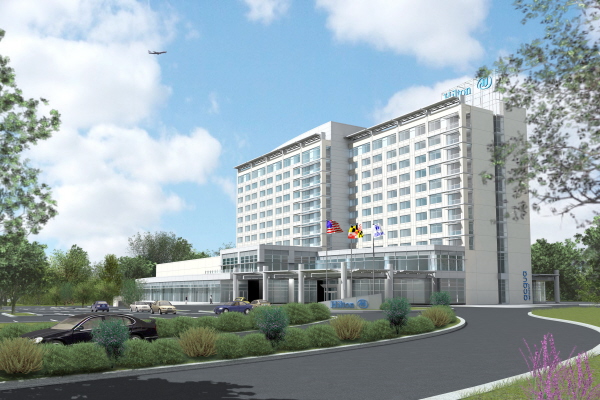Building Statistics
General Building Data
Building Name: Hilton Hotel at BWI Airport
Location and Site: 1739 West Nursery Road
Linthicum Heights, Maryland 21090
Building Occupant Name: Hilton Hotel
Function Types: Hotel, Ballroom/ Assembly, Restaurant, 80-car Parking Garage below ground
Size: 203,300 s.f.
Number of Stories above Grade: 11-Story + Penthouse
Primary Project Team:
Owner - Buccini-Pollin Group (www.bpgroup.net)
Architect - Brennan Beer Gorman Monk (www.bbg-bbgm.com)
General Contractor – HITT Contracting Inc. (www.hitt-gc.com)
Structural Engineer – Holbert Apple Associates (www.holbertapple.com)
MEP – R G Vander Weil Engineers (www.vanderweil.com)
Geotechnical Engineer- ECS, Ltd. (www.ecslimited.com)
Lighting Consultant – Architectural Lighting by Shugarman
Dates of Construction: April 25, 2005- September 21, 2006
Project Construction Cost: $35 million
Project Delivery Method: Design-Bid-Build
Applicable Codes:
International Building Code (IBC) 2003 with Local Amendments
NFPA 101 Life Safety 2000
International Mechanical Code 2003
International Plumbing Code 2003
Accessibility: COMAR 05.02.02, AADAG
Anne Arundel County Code: Zoning
Zoning Classification:
W-1
R-1 Residential
Lot Area: 13.38 acres
Maryland Aviation Administration (MAA): Airport Zoning
Federal Aviation Administration (FAA): Obstruction Evaluation
Architecture
This 11-story Hilton Hotel has a façade of a tan pre-cast concrete blended with Architectural metal panels and various glazing complimented with metal light shades. The grand entrance to the hotel brings you around a circle under the porte coche for bag drop off and check-in. The ground floor has an elaborate 16,000 s.f. ballroom with an adjacent assembly/ pre-function room. The hotMay 6, 2007ecreation offers a swimming pool and hot tub on the second floor as well as an exercise room nearby. Guest rooms vary from single king bed rooms to a Presidential Suite. An 80-car parking level is located underneath the hotel ground floor.
Building Envelope
Pre-cast Concrete Panels with Four connection types:
• Panel to column with steel angle
• Panel to Column with tie back connection
• Connection with embedded plates in concrete beam
• Panel connected to mid-span of beam via steel angle and embedded plate
Metal Fascia and Architectural Metal Panels are blended in areas to break up the pre-cast concrete façade.
Windows: Mix usage of Vision Glass (VG) and Vision Spandrel Glass (VGS) with aluminum coated mullions. Metal light shade devices are secured to vertical mullions of window system.
Roof: Fully Adhered Single Ply EPDM Roof on R-30 Rigid Insulation
Structural
The structural system of the Hilton Hotel at BWI Airport varies throughout the building. Cast-in-place reinforced concrete is the primary structural entity. Typical guest room floors (floors 4-11) resist gravity loads with a two-way post tensioned flat plate system. Gravity loads are resisted on floors ground through three by two-way mild reinforced concrete slab with drop panels. The penthouse roof system is a two-way post-tension concrete slab with drop beams. Reinforce concrete columns varying in size carry gravity loads to spread footing foundations. Lateral loads are resisted by a series of shear walls extending vertically from the foundation throughout the building. Shear walls transfer later loads to reinforced concrete mat foundations.
The double-heighted ballroom, adjacent assembly room, and main entrance spaces are all enclosed by a structural steel system. Corrugated metal roofs decks transfer gravity loads to steel members, which in turn transfer load to W-shape steel columns that frame into concrete piers.
Construction
Construction on the Hilton Hotel at BWI Airport began April 25, 2005. Design-bid-build was the delivery method of the project with HITT contracting, Inc. being the general contractor (GC). The cast-in-place concrete super structure was placed using both a concrete pump and tower crane bucket. Floors ground through 8 used a pump to place slabs while using a crane and bucket to place columns. All concrete placement exceeding floor level 8 utilized the crane and bucket procedure. Pumps are available that can pump concrete over a height of 90 feet (floor level 8), but for economy a crane and bucket carried out the placement. As construction continued, locations of original penetrations in the post-tensioned slabs changed with various trades. Coordination with the trades and the structural engineer of record was a task handled by the GC regularly. Substantial completion of the project was September 21, 2006.
Mechanical
Four Air handling units supply 64,100 CFM throughout the building. VAV with local water reheat and plenum return are utilized in each of the systems. Two plate and frame heat exchangers 4000 & 7000 MBH pre-heat air in the system. Two centrifugal chillers each have 180 ton capacities are utilized to cool air in the system. Location of the cooling tower is on grade. Heating of the system is produced by two fossil fuel boilers, each 4,185 MBH in capacity, located on the parking level below grade.
Electrical/ Lighting
Power distribution for the hotel is supplied by BGE with one 13.2 kV circuit stepped down to 480/277 volts for low voltage distribution through out the hotel. The secondary switch boards are rated at 4000 amp 480Y/ 277 V, 3-phase, 4-wire. The first switchboard serves the parking level through second floor. Emergency power distribution shall consist of a 600KW diesel stand-by generator located in the utility yard on the exterior ground level.
Majority of interior lighting are fluorescent fixtures having electronic ballasts and T-8, 85 CRI, 3500 dg. K lamps. Hotel suites and entry areas defined by architectural accents utilize incandescent lighting. The ballroom and meeting room use a mix of fluorescent and incandescent lighting. Normal emergency life safety circuits serve emergency lighting. Egress routes are marked with LED exit signs, connected to emergency circuits.
